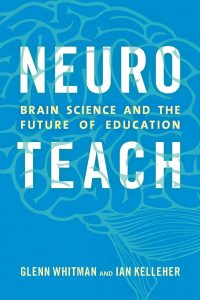Thanks to @jmedved for the recommendation of “NeuroTeach“. Written by Glenn Whitman and Ian Kelleher, this is a great book that should be central to schools’ professional development library. NeuroTeach is a culmination of what we know about the brain, how we learn, what non-neural factors influence learning (hint: feelings!), and practical strategies for being a Mind Brain Educator.
Teachers are researchers. They collect enormous amounts of data each day, and they rapidly evaluate and make decisions based on those data. Some of this is numerical, but much is qualitative. They may be second only to doctors in doing this. What teachers are not good at is doing anything formal with these data. Like a cup under a running tap, more and more information is constantly flowing in, too much to hold. All these data could be used as evidence to inform practice (NeuroTeach, 149)
You would be interested in reading this book if…
1) You wanted solid brain research to understand learning process in students
2) You wanted researched-supported strategies for deep learning
3) You were looking for ways to capitalize on strategies that leverage the way the brain learns
4) You want to shift your practice into that of a Teacher-as-Researcher and do something formal with the data you collect
The goal for the authors is to create a research-based approach to education: “Perhaps the most fundamental premise of mind, brain educations (MBE) science is that we can, and must, manage these factors in ways that promot the kind of changes that lead to stronger, happier, more motivated, more resilient, high-achieving students.” (NeuroTeach, 34)
To this end, throughout the first chapters of the book, the reader is given a tour of the brain within the context of education. This is an important piece because the information is directly applicable to the classroom, relationship and content of learning.
Getting sensory information to your prefrontal cortext is crucial for learning, and the key is the role of the amygdala and ho you cope with stressors. Working at this leads to myelination of the neural pathways from the amygdala to the prefrontal cortex, meaning that doing so becomes easier over time. Research shows that moderate levels of stress in short, defined periods, and in a supportive environment help rewire the brain to deal more effectively with stress in the future. The right amount of stress in the right conditions does indeed make you strong. (NeuroTeach, 36)
This connects back directly to the work of Lisa Damour and the differences between stress and anxiety. In her book “Under Pressure” she writes:
We don’t want our daughter’s stress level to be consistently too low or too high. But we can embrace reasonable levels of stress as a nutrient for our daughter’s healthy development that will help her grow into the strong and durable young woman we want her to be. (pg. 4)
The authors of NeuroTeach share the same approach:
So the teacher must ensure that each individual student is in what we might call his or her zone of proximal discomfort – for this student at this time, what is a good level of stress and what can I do to help balance his or her stressors? (pg. 75)
What they propose is to actually have the educators in the building engage in dialogue with students about their brain, its structure and how it is built. In turn, this will inform their strategies and allow them to make sense of new strategies that are brain-research informed.
This book also goes deep into how an educator can use Mind Brain Education science to improve their own practice as a learner. They encourage teachers to consider this key question: “…how do we structure professional development to help us so that our kids don’t just end up learning what we did and the way we did it decades ago?”
What are we as educators learning, and how are we learning it, such that it will change the way we teach from the way we taught, erase neuro-myths from our repertoire of teaching, and allow us to craft approaches that we know are effective, efficient and impactful for high impact learning?
Their recommendation that I really gravitate towards is the “Research-informed Reflective, Iterative Practice done Collaboratively” (pg. 165). “We want reasonable responses to genuine problems in a reasonable timescale. So let’s play in the sandbox. As long as we take care to make sure that solutions are informed by research in their inception; as long as we take care to get feedback, reflect, tweak and try again so that our process is iterative; as long as we take care to make sure we are actually collecting and using evidence, and doing so appropriately, we will be moving in the right direction. “ (pg. 166)
How often do we encourage our own students and even ourselves to play in the sandbox?

